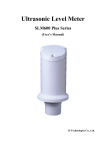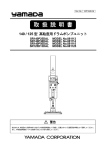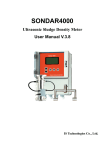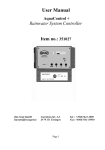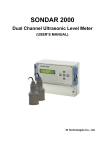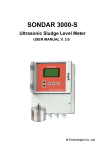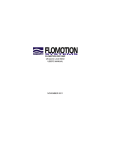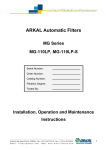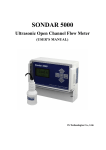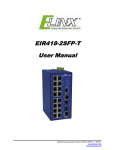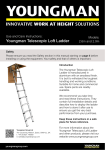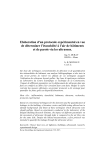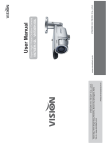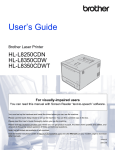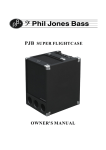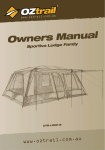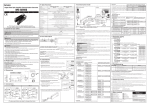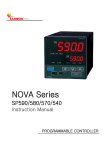Download Ultrasonic Level Meter SLM600 Plus Series
Transcript
Ultrasonic Level Meter SLM600 Plus Series (User’s Manual) IS Technoloigies Co., Ltd. November 2000 COPYRIGHT © IS Technologies Co., Ltd. All rights reserved. No part of this publication may be reproduced, transmitted, transcribed, stored in a retrieval system, or translated into any language in any form without the written permission of IS Technologies Co., Ltd. WARRANTY AND LIABILITY IS Technologies Co., Ltd. guarantees for a period of 1 year from the date of delivery that it will either exchange or repair any part of this product returned to IS Technologies Co., Ltd. if it is found to be defective in material or workmanship, subject to the defect not being due to unfair wear and tear, misuse, modification or alteration, accident, misapplication or negligence. DISCLAIMER IS Technologies neither gives nor implies any process guarantee for this product, and shall have no liability in respect of any loss, injury or damage whatsoever arising out of the application or use of any product or circuit described herein. Every effort has been made to ensure accuracy of this documentation, but IS Technologies cannot be held liable for any errors. TECHNICAL ENQUIRIES Please contact IS Technologies Co., Ltd. for technical support. COMMENTS AND SUGGESTIONS If you have any comments or suggestions about this product, then please contact: IS Technologies Co., Ltd. 203/504 Buchon Techno Park, 192 Yakdae Dong, Wonmi Gu Buchon City Kyungki Korea Tel: 82-32-621 2606 Fax: 82-32-621 2612 Web Site: http://www.istec21.com e-mail: [email protected] Contents Chapter 1 Start Here…............................................................................................................................................................................... 4 About this Manual......................................................................................................................................................................................4 About the SLM 600 Level Monitoring System.......................................................................................................................................5 Functional Description...............................................................................................................................................................................5 Product Specification.................................................................................................................................................................................7 Chapter 2 Installation ................................................................................................................................................................................. 8 Power Supply Requirements .....................................................................................................................................................................8 Terminal Connections............................................................................................................................................................................. 11 Preparation for Operation ....................................................................................................................................................................... 12 Maintenance ............................................................................................................................................................................................ 12 Chapter 3 How To Use Your SLM 600 Level Monitoring System ....................................................................................................... 13 Operating the Controls............................................................................................................................................................................ 13 Display............................................................................................................................................................................................... 13 Run Mode.......................................................................................................................................................................................... 13 Program Mode .................................................................................................................................................................................. 13 How to Access Program Mode .............................................................................................................................................................. 14 What to Do First................................................................................................................................................................................ 15 Chapter 4 Menu Guide............................................................................................................................................................................. 16 Application Menu Options ..................................................................................................................................................................... 16 Process Menu Options ............................................................................................................................................................................ 17 Compensation Menu Options................................................................................................................................................................. 18 Switched Outputs Menu Options ........................................................................................................................................................... 19 Chapter 5 Troubleshooting ...................................................................................................................................................................... 20 Menu Option Record............................................................................................................................................................................... 21 Chapter 1 Start Here… Congratulations on your purchase of a Sondar Ultrasonic Level Meter 600 Series. This quality system has been developed over many years and represents the latest in high technology ultrasonic level measurement and control. It has been designed to give you years of trouble-free performance, and a few minutes spent reading this operating manual will ensure that your installation is as simple as possible. About this Manual It is important that this manual is referred to for correct installation and operation. There are various parts of the manual that offer additional help or information as shown: Tips TIP At various parts of this manual you will find tips to help you. Additional Information Additional Information At various parts of the manual, you will find sections like this that explain specific items in more detail. Page 4 About the SLM600 Series Functional Description The Sondar SLM600 Series is a highly developed ultrasonic level measurement system which provides non-contacting level measurement for a wide variety of applications in both liquids and solids. Easy calibration and maintenance free “fit and forget” performance mean that you can install the SLM600 Series rapidly and with confidence. Two Switched outputs NPN open collector, with fully programmable setpoints are provided in the 3 wire version, together with fault condition being indicated by the mA output on both the 2 and 3 wire versions. The Sondar SLM600 Series operates on the principle of timing the echo received from a measured pulse of sound transmitted in air and utilise “state of the art” echo extraction technology. It can measure distances from 0.35m to 6m from the face of the transducer to the surface being monitored, dependent on the material being measured. Page 5 The SLM600 Series can show level, space, distance, on the display. The switched outputs can be programmed to give an ‘ON’ and ‘OFF’ point for external control. There is a 4-20 mA output that can be connected to a remote chart recorder or PLC, to monitor level, space or distance, dependant on the measurement mode selected, and provides a ‘fault condition’ alarm of either 3.8mA or 21mA. The Sondar SLM600 Series has an IP65 lid covering an integral LCD display and 4 buttons used for programming purposes, together with 4 LED’s which provide status information whilst in RUN and PROGRAM Mode. Page 6 Product Specification Physical Dimensions overall 105 (dia). x 248.5 (height) mm electronics housing 105 (dia). x 172 (height) mm transducer housing 55 (dia) x 76.5 (height) mm mounting 2” NPT Weight Nominal 1.5 kg Case material/description Polypropylene Cable entry detail 1 x PG9 at rear (fitted with gland) Environmental IP Rating (electronics housing) IP65 Max. & Min. temperature (electronics) -20 ºC to +70 ºC (-4 ~ 158°F) Pressure up to 2 Bar CE approval EMC approval to BS EN 55011:1991 (Class A),. BS EN50082-2: 1995 BS EN61000-4-2:1995 BS ENV50140:1993 BS ENV50141:1993 BS ENV50204:1995 BS EN61000-4-4:1995 Performance Accuracy 0.25% of the measured range or 3 mm (whichever is greater) Resolution 0.03% of full scale or 1mm (whichever is greater) Max. range Liquids 256 inches Min. range 14 inches Beam Angle 13o at -3dB. Damping Rate Adjustable 0.35f/min to 350f/min Temperature Compensation Fully compensated via integral temperature sensor over entire operational span Outputs Analogue output 4-20 mA into max 750Ω (user adjustable) Fault condition Alarm 3.8mA or 21mA user selectable. NPN Open Collector switched output 2 Switched outputs, user programmable setpoints. Display 3 Digit LCD Display Programming On-board programming via 4 tactile push button keys Supply Power supply DC 20 - 30V Current Consumption Less than 0.08A Page 7 Chapter 2 Installation Power Supply Requirements The SLM600 operates from a DC supply of 20 –30V and will typically draw less than 0.08A. All electronic products are susceptible to electrostatic shock, so follow proper grounding procedures during installation. The compact one-piece construction of the SLM600 can be mounted easily using the integral nose thread (2”NPT or 2” PF). When choosing a location to mount the SLM600, bear in mind the following: • For easy access to the LCD display and programming buttons mount it where it is easily accessible. • The ultrasonic signal path should be free of falling material and obstructions such as pipes, beams etc. • The SLM600 should be mounted at least 1.15feet above the maximum level of the material and be perpendicular to the surface. • The mounting surface should be vibration-free. • The ambient temperature is between -4°F to 158°F • There should be no high voltage cables or electrical inverters close by. • Do not use any metal substances when installing (Please use the PVC nut & flange supplied as option) Dimensions The dimensions of the SLM600 are as shown below 7 c a b le T h re a d 2 " N P T ,P F 2" m o u n t in g Page 8 Outdoor and Open Vessel Installation The SLM600 can be simply mounted on a bracket, suitable for the application and secured using the thread located at the top of the transducer (2”NPT). Care should be taken to ensure that the SLM600 is not installed in direct sunlight, in order to avoid errors in the measurement of ambient temperature. Attention should also be taken, when mounting the unit, to ensure that strong windy conditions are avoided, wherever possible, to prevent abnormal operation. Bracket 35 cm Minimum Nut Closed Vessel Installation The SLM600 can be simply screwed into a flange and secured using the thread located at the top of the transducer (2”NPT). Where possible use a flange made of a synthetic material such as PVC, to avoid vibration Place a rubber gasket between the flange of the Sondar and the connection to the vessel to avoid vibration. Page 9 Stand Pipe Installations When mounting the SLM600 to a standpipe care should be taken to ensure that the standpipe is of sufficient dia with reference to its length, see the table below for details: L(mm) D (mm) Length (mm) 80 220 100 280 150 420 200 560 D(mm) When using a standpipe, fixed to the top of a vessel, ensure that the open end of the standpipe is clear of any obstructions such as weld seams, gaskets etc. in order to avoid unwanted signal returns. If using standpipes, which extend into the vessel, beyond the blanking distance, but not as far as the empty level, then the open end of the standpipe should be cut to an angle of 45o. The maximum Pipe should be free Incorrect level (100% of of obstructions Standpipe Span) is inside the such as weld seams size Blanking Distance Page 10 Cable Entry The SLM600 Series has a single PG11 cable entry, fitted with a suitable gland, to ensure moisture protection is maintained. Terminal Connection Details The SLM600 Series comes in both 2 wire and 3 wire versions the terminal connections for both are as detailed below. Wiring details are also given on the terminals under the access cover. 3 Wire 2 Wire V+ Io V+ Terminal Connections 2 Wire(SLM600B) ♦ V+: Direct Current (DC) input terminal (20-30VDC) ♦ Io: Current Output terminal (4-20mA) 3 Wire(SLM600A) ♦ V+: Direct Current (DC) input terminal (20-30VDC) ♦ COM: DC COMMON input terminal, and also used as RETURN terminal for all OUTPUTS ♦ Io: Current Output terminal (4-20mA) ♦ L1: Limit 1 Switched Output terminal (NPN Open Collector) ♦ L2: Limit 2 Switched Output terminal (NPN Open Collector) ♦ DET : Service use only Page 11 COM Io L1 L2 DET Important Information If the equipment is installed or used in a manner not specified in this manual, then the protection provided by the equipment may be impaired. Preparation for Operation Before switching on, check the following: 9 The SLM600 is mounted correctly. 9 The power supply is correctly installed. Maintenance There are no user serviceable parts inside your SLM600, if you experience any problems with the unit, then please contact IS Technologies Co., Ltd. for advice. To clean the equipment, wipe with a damp cloth. Do not use any solvents on the enclosure. Page 12 Chapter 3 How To Use SLM600 Series Operating the Controls Display Whilst in the Run Mode, the 3-digit LCD display will show the current level reading in centimetres, it will also display a flashing “0” when a fault condition (Loss Of Echo) is detected. When in the Program Mode the display is used to read information on the Menu Options and the values entered. There are two operating modes for your SLM600, Run Mode and Program Mode. Run Mode This mode is used once the SLM600 has been set up in program mode. It is also the default mode that the unit reverts to when it resumes operation after a power failure. When the SLM600 is switched on for the first time, it will display, in centimetres, the distance from the transducer face to the target. After programming is complete, any switched outputs that are set will operate when the level reaches the relevant setpoint. Whilst in Run Mode the Detect and Distance LED’s provide information on the status of the signal. Program Mode This mode is used to set up the SLM600 or change information already set, this is achieved by using the 4 push buttons located either side of the display. Entering a value for each of the menu options that are relevant to your application provides all the programming information. Page 13 How to Access Program Mode To access the Program Mode simply press the “Mode” button. Confirmation that you have entered the Program Mode will be given by the Detect and Mode (Level, Distance, Space) LED’s being extinguished, and the Software Version will also appear in the display. Each subsequent press of the Mode button will advance you through the options, 01 to 17 (depending on model), values of which can be changed by using the Up and Down buttons. To return to the Run mode simply press the Run button, confirmation that the SLM600 has returned to Run successfully will be given by the LCD display indicating the level and the Detect and Mode (Level, Distance, Space) LED flashing. Button Functions There are 4 push buttons, 2 located each side of the display their functions are as follows: Button Mode Run Run Mode Program Mode Access Program Mode Advance through Menu Options Not used Return SLM600 to Run Mode Displays measured level in inches. Eg. Reading in Run indicates 250 inches, when button pressed 503 displayed this indicates that reading is 2503mm. Increase Menu Option value Reads Current Temperature N.B. –20oC displayed as 020 +20oC displayed as 20 Decrease Menu Option value LED Functions There are 4 LED’s, located above the display their functions are as follows: LED Page 14 Condition Detect & Level Detect & Distance Detect & Space Flashing together Detect Flashing alone None All Off Display indicates flashing “0” Flashing together Flashing together Function Indicates Normal Operation Mode selected = Level Indicates Normal Operation Mode selected = Distance Indicates Normal Operation Mode selected = Space Indicates that SLM600 is detecting an echo but checking if the value is correct. Indicates that SLM600 has gone into Fail condition (LOE). What to Do First When you first switch the SLM600 on, it will be reading the distance from the face of the transducer to the surface in centimetres, as shown on the display. TIP In some applications it is simplest to empty the vessel, take a reading from the SLM600 for distance and then setup the empty level to this figure. Once you are satisfied with the installation, and the SLM600 is reading what you would expect in terms of distance from the face of the transducer to the material level, then you can set up the options as detailed in Chapter 4 Menu Guide. Page 15 Chapter 4 Menu Guide This chapter describes all of the menu options in your SLM600, in numerical order. Application Menu Options 01 Operating Mode Factory Set = 1 Level This option sets the mode of operation when in run mode, and can be set to one of the following: Option Description 1= Level Display shows how full the vessel is with respect to the Empty (0% of Span) 2= Distance Display shows the distance from the transducer face to the surface. 3= Space Display shows how an empty vessel is with respect to Full (100% of Span) i.e. how much space is available in the vessel. 02 Empty Level Factory Set = 256 This option is to sets the maximum distance from the face of the transducer to the empty point, in inches. 03 4 mA Setpoint Factory Set = 0 This option sets the distance (or level or space, depending on the selected Operating Mode (Option 01) at which the 4mA output will occur. By default 4mA will represent Empty (0% of Span) 04 20 mA Setpoint Factory Set = Span This option sets the distance (or level or space, depending on the selected Operating Mode (Option 01) at which the 20mA output will occur. By default 20mA will represent Full (100% of Span) Important Information The Span is the maximum working distance from Empty (0%) to Full (100%), and is automatically calculated as Empty Level (Option 02) minus Blanking Distance (Option 05). Except for when Operating Mode (Option 01) = Distance in this case the Span is the same as the Empty Level (Option 02) 05 Blanking Distance Factory Set = 14 This option is the distance from the face of the transducer that is not capable of being measured, and is pre-set to 14 inches. It should not be set to less than this figure, but can be increased if required. Page 16 Process Menu Options 06 Output Power Factory Set = 3 This option is used to set the power output from the transducer to suit varying applications.. By reducing the power emitted the beam angle will be effectively reduced and can be applied as detailed below: Option Description 1 = Minimum Power For use on short range applications 2 = Low Power For use on applications where obstructions such as pipes, beams etc. are present. 3 = Normal Power For use in normal conditions 4 = High Power For use in arduous applications where conditions are dusty, steamy or turbulent. 07 Damping Rate Factory Set = 2 (3.5f/min). This option determines the maximum rate at which the unit will respond to an increase/decrease in level. Option Description 1 = 0.35f/min Responds to changes to a max. 0.35f/min 2 = 3.5fmin Responds to changes to a max. 3.5f/min 3 = 35f/min Responds to changes to a max. 35f/min 4 = 350f/min Responds to changes to a max. 350f/min 08 mA Fail-safe Value Factory Set =2 (21mA) If the SLM600 Series fails to receive a valid echo return from the target, then the mA output can be used to indicate a fault condition (Loss of Echo). This option determines the mA output value which will indicates such a condition. Option Description 1 = 3.8mA Fault condition (LOE) indicated by 3.8mA 2 = 21mA Fault condition (LOE) indicated by 21mA 09 mA Fail-safe Time Factory Set = 120 seconds In the event of a fail-safe condition occurring (LOE) the fail safe timer determines the time before the mA output indicates a fault condition (LOE). Page 17 Compensation Menu Options 10 Sound Velocity Factory Set = 331 m/sec This option allows for the velocity of sound to be changed according to the atmosphere the transducer is operating in. By default the velocity is set for sound travelling in air at a temperature of 0oC. The table below gives details of the velocity of sound in various gaseous atmospheres In all cases the velocity indicated is that in a 100% gaseous atmosphere at 0oC. In atmospheres less than 100% it may be necessary to check the level indicated at near empty and near full and compare with the actual level, several times, then adjust the Sound Velocity accordingly to obtain an accurately displayed reading. Gas Chlorine Carbon Dioxide. Argon Oxygen Air Ammonia Methane Helium Neon Sound Velocity 206 m/sec 259 m/sec 308 m/sec 316 m/sec 331.5 m/sec 415 m/sec 430 m/sec 435 m/sec 965 m/sec 11 Vapour Temperature Compensation Factory Set = 60 cm/oC The sound velocity in air increases or decreases at a uniform rate of 60cm/ oC , however in atmospheres other than air it will change at a different rate. This option allows the rate of change in cm/oC to be set according to the present atmosphere and temperature. The level indicated, should be compared with the actual level, several times, then Vapour Temperature Compensation adjusted accordingly, to obtain an accurately displayed reading. 12 Material Temperature Factory Set = 25oC The SLM600 Series uses an internal temperature sensor, housed within the transducer nose cone and therefore the temperature used for compensation is that which is near the sensor. In applications where there is a large difference between the temperature near the sensor and that at the surface of the material being measured, errors in measurement may occur. This option allows for the present temperature at the material surface to be entered and reduce any error in measurement. The temperature of the material should be entered in oC. Page 18 13 Reflected Temperature Ratio Factory Set = 0 This option is used in conjunction with Option 12, Material Temperature and determines the effect the material temperature has on the air temperature in front of the transducer. Where the temperature of the material has no effect on the air temperature Option 13 should be set to 0, in which case Option 12, Material Temperature will be ignored. However in cases where the material temperature heavily influences the temperature at the transducer Option 13 should be set to 100 and temperature compensation will be performed accordingly. Switched Outputs Menu Options 14 Limit 1 ON Setpoint Factory Set = 100cm This option determines the “ON” point for L1 Switched Output (NPN Open Collector). Setpoints are entered in centimetres measured from the Empty Level. 15 Limit 1 OFF Setpoint Factory Set = 110cm This option determines the “OFF” point for L1 Switched Output (NPN Open Collector). Setpoints are entered in centimetres measured from the Empty Level. 16 Limit 2 ON Setpoint Factory Set = 500cm This option determines the “ON” point for L2 Switched Output (NPN Open Collector). Setpoints are entered in centimetres measured from the Empty Level. 17 Limit 2 OFF Setpoint Factory Set = 490cm This option determines the “OFF” point for L2 Switched Output (NPN Open Collector). Setpoints are entered in centimetres measured from the Empty Level. Page 19 Chapter 5 Troubleshooting This section describes some problem symptoms, with suggestions as to what to do. Symptom Display blank, transducer not firing. What to Do Check power supply Display shows flashing “0” and all LED’s are Off. No valid echo being received and unit has gone into fault condition. Check material level is not out of range, sensor is perpendicular to material surface. Displays appears frozen on wrong reading and only the “Detect” LED is flashing. Check that the Response Rate (07) is appropriate for the application. Ensure that there are no obstacles in the ultrasonic signal path. Material level is consistently incorrect by the same amount. Check empty level (02) correctly entered. Page 20 Menu Option Record SLM600 Series (2 and 3 wire) APPLICATION No. 01 02 03 04 05 Option Details Description Operating Mode Empty Level 4mA Setpoint 20mA setpoint Blanking Distance Factory Set 2 = Distance 600cm 0 Empty Dist. 35cm Output Power Damping Rate mA Fail Safe Value Fail Safe Time Sound Velocity 3 2 2 120 sec 331m/sec 1 Entered Values 2 1 2 3 4 5 4 5 PROCESS 06 07 08 09 10 COMPENSATION 11 12 13 Vapour Temp. Comp. Material Temperature Reflected Temp. Ratio 60cm/oC 25oC 0 SLM600A (3 wire) SWITCHED OUTPUTS No. 14 15 16 17 Page 21 Option Details Description Limit 1 ‘On’ Setpoint Limit 1 ‘Off’ Setpoint Limit 2 ‘On’ Setpoint Limit 2 ‘Off’ Setpoint Factory Set 100 110 500 490 Entered Values 3





















